10 Top Plants Native to the Desert Southwest
The intense heat of summer and the cold winters of the Southwest are not for the faint of heart, and these native plants do more than just grow in the desert’s often unforgiving environment. They have special adaptations that allow them to thrive in the arid regions of the U.S. Southwest, handling not just the extreme dry heat but also the freezing temperatures of winter. Many of these natives are also an important source of nectar for birds and bees, and some provide nesting sites for native bird species. Each one of these plants is drought tolerant and adds beauty to the desert landscape.
Plants native to the desert require full sun, but some can tolerate light shade for part of the day. Deep, infrequent watering and well-drained soil are the keys to healthy native desert plants. Allow water to permeate down to at least 1½ to 2 feet deep and allow the soil to dry out before watering again. Drip irrigation is the most efficient method of irrigating plants in the Southwest. New plants will need more water until established. Dig holes for new plants that are three times the width of the root ball, which will help the plants grow roots and become established more quickly. Supplemental fertilizer is seldom required for these desert natives.
Not in the Southwest? Browse plants native to other regions of the U.S.
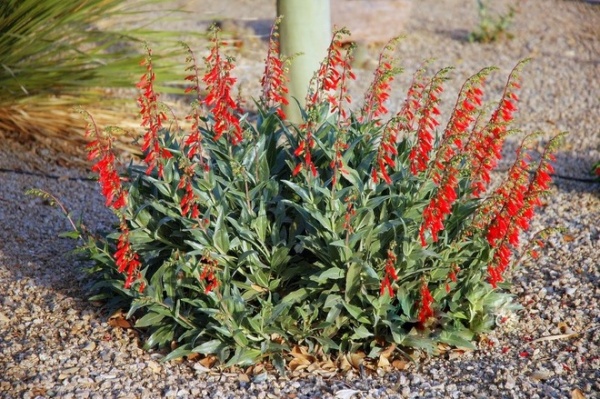
Firecracker Penstemon
(Penstemon eatonii)
Native to southwestern Colorado and Utah to Arizona and southwest California, growing along washes and rocky hillsides in elevations of 2,000 to 7,000 feet
Best plant for winter and spring color. The orange-red spikes of firecracker penstemon decorate low-desert gardens in winter and on into spring, providing much-needed color in drab winter landscapes, when it is hard to find anything else in bloom. The orange-red flowers provide an important source of nectar for hummingbirds in winter, when there are fewer flowers for them to feed from. In high-desert areas, this drought-tolerant perennial flowers a bit later — in spring and summer.
Firecracker penstemon handles cold winters and hot summers, and looks great when paired with yellow-flowering perennials, such as angelita daisy, damianita and desert marigold, which provide great color contrast in the garden, since they all bloom at the same time. Plant it in full sun or partial shade in well-drained soil for best results.
See how to grow firecracker penstemon
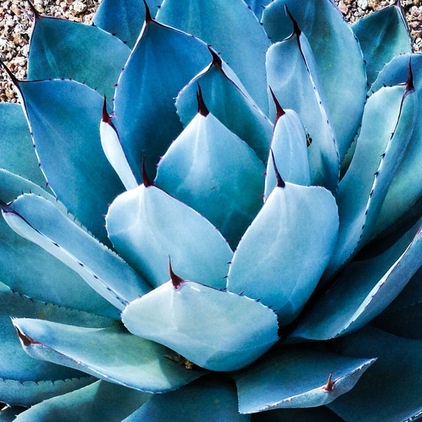
Parry Agave
(Agave parryi)
Native throughout central Arizona and New Mexico, on into western Texas and arid regions of Mexico on rocky slopes and grasslands, from 1,500 to 8,000 feet in elevation, depending on the variety
Best agave for desert landscapes. Agaves are the backbone of many Southwestern landscapes, and there are many species to choose from, ranging from large, heavily toothed agaves to those that are tiny, reaching 6 inches tall and wide. Parry agave is a great choice for the landscape due to its medium size (2 to 3 feet tall and wide) and the unusual colors and shapes of its leaves. In addition, parry agave can handle colder temperatures than many other species of agave can, while thriving in exposures with hot, reflected sun to partial shade.
Parry agave is prized for its beauty, particularly the variety ‘Truncata’, with its gray-blue leaves and maroon thorns. Plant it in groups of three to five interspersed with flowering ground covers, such as sandpaper verbena (Glandularia rigida) and trailing purple lantana (Lantana montevidensis). This midsize agave also makes a great container plant.
See how to grow Parry agave
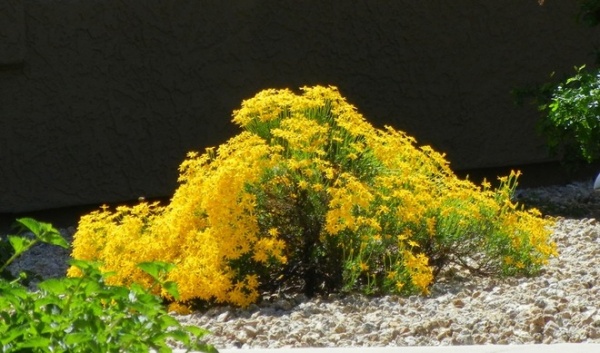
Damianita
(Chrysactinia mexicana)
Native to the Chihuahuan desert regions of New Mexico, Texas and Mexico, growing in elevations of 2,000 to 7,000 feet
Toughest ground cover. It’s hard to imagine this delicate-looking plant thriving in the extreme heat and cold of the Southwest desert. But this drought-tolerant ground cover doesn’t just survive these seemingly inhospitable areas; it actually thrives in areas with full, reflected sun. In spring and fall, the dark green, aromatic foliage of damianita is transformed when masses of golden yellow flowers appear, covering the entire plant.
Damianita adds a splash of bright yellow, which contrasts beautifully with the red flowers of firecracker penstemon and Valentine bush and the purple flowers of desert ruellia. This tough ground cover grows best in well-drained soil and in areas that receive full sun.
See how to grow damianita
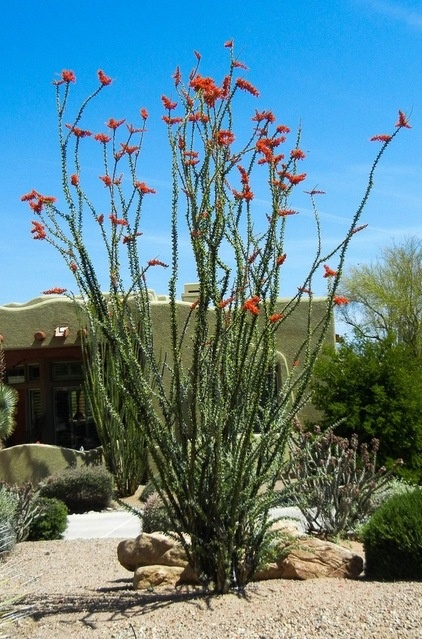
Ocotillo
(Fouquieria splendens)
Native to the deserts of Southern California, stretching toward west Texas and south into Baja California and Sonora, Mexico, where it can be seen growing on flat desert land and rocky slopes up to 5,000 feet in elevation
Best ecological benefit for migrating hummingbirds. If you’ve driven through the Southwestern desert, then you’ve undoubtedly seen the graceful canes of ocotillo reaching toward the blue desert sky. Often mistaken for cactus, ocotillo is actually a drought-deciduous shrub uniquely suited for the desert. Its brown canes respond to rain showers and humidity by suddenly sprouting small, green leaves that cover them.
The vermillion-colored flowers are borne at the tips of the canes in spring and provide a vital source of nectar for hummingbirds as they migrate up from the south through the desert in spring. Ocotillo has the only native desert flower that appears regardless of drought, which is why hummingbirds depend on its nectar and the energy it provides when migrating.
Ocotillo can be grown from bare-root transplants or from field-grown specimens. It must be planted in an area that receives full sun.
See how to grow ocotillo
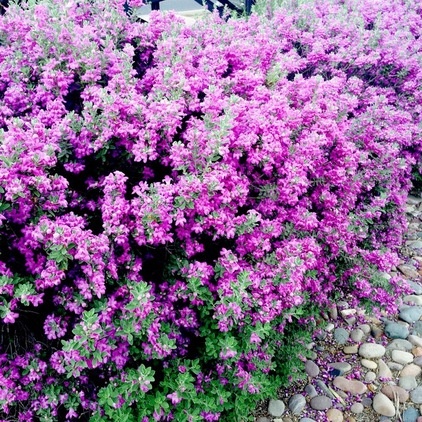
Texas Ranger
(Leucophyllum frutescens)
Native to the southwestern areas of Texas and northeastern Mexico, where it can be found growing throughout the desert along hillsides and washes
Most impressive flowering shrub. The sight of Texas ranger in full bloom slows down traffic and causes people to take a second look at the brilliant purple blooms that cover every square inch of it. This purple beauty is referred to as barometer bush, due to the fact that it often flowers in response to humidity and rainfall in summer and fall. Even when not in flower, these large shrubs are attractive with their evergreen gray-green foliage.
As you may have guessed from the name, Texas ranger is native to the southwestern region of Texas, and like most things from Texas, this shrub is big, so be sure to allow enough room for it to reach its mature size of 6 feet tall and wide. Texas ranger is one tough shrub that can handle areas with full sun and reflected heat.
See how to grow Texas ranger
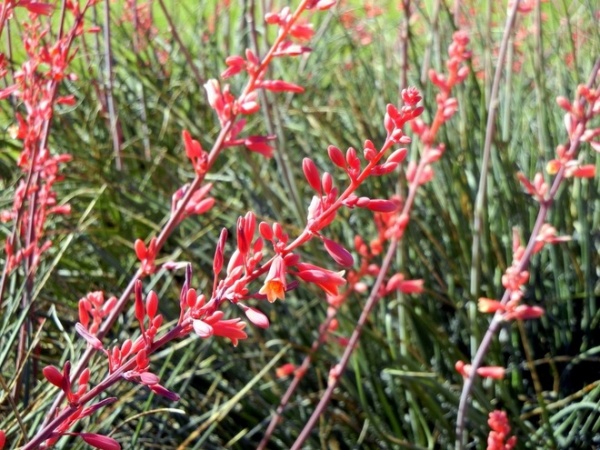
Red Yucca
(Hesperaloe parviflora)
Native to central and southwestern regions of Texas and the neighboring Coahuila region of Mexico
Best plant for full, reflected sun. The best plants for any landscape look great, are adapted to the climate and need little care. Red yucca checks all of these boxes, making it a must-have for the desert garden.
This Texas native has succulent leaves that resemble an ornamental grass. In spring and early summer, spikes of coral-colored flowers are borne on the grass-like foliage. While not a true yucca, it looks great planted next to boulders in groups of three or five.
Intense summer heat and winter cold aren’t a problem, and in fact, red yucca thrives in seemingly inhospitable areas that receive full, reflected afternoon sun, while adding color and texture to the Southwestern landscape.
See how to grow red yucca
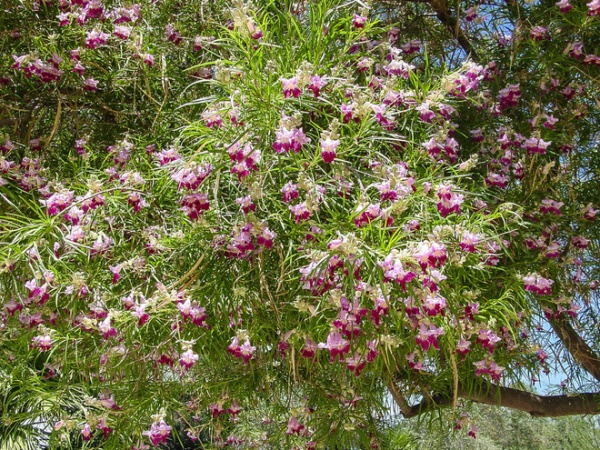
Desert Willow
(Chilopsis linearis)
Native to south-central Texas south to Mexico and west to southern California and Baja California, growing alongside desert washes
Best midsize desert tree. Summer gardens come alive when the large, colorful blossoms of desert willow burst forth. While not a true willow, it has bright green foliage that adds a visually cooling effect to summer gardens. Hummingbirds from all around are attracted by the pink and magenta flowers that appear from spring through fall, which provide light, filtered shade for plants below.
While many desert trees can grow upward of 30 feet tall and high, this medium-size deciduous tree is perfectly suited for medium-size spaces, where its 20- by 15-foot spread can easily fit. Most often available as a multitrunk tree, desert willow is thornless, which makes it great for spaces next to patios, courtyards or street plantings. There are many varieties available with varying flower colors, bloom periods and number of seedpods.
See how to grow desert willow
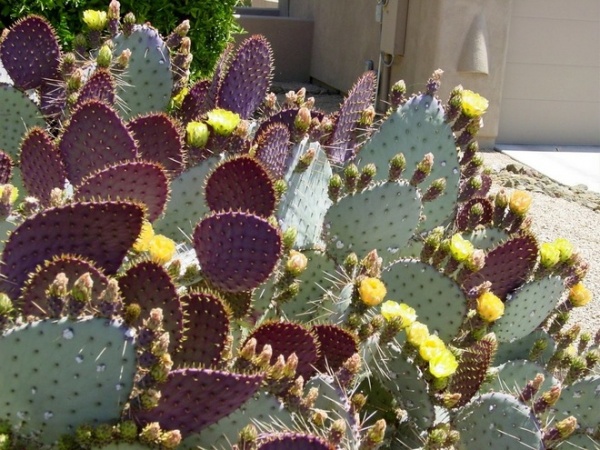
Santa Rita Prickly Pear
(Opuntia violaceae santa-rita)
Native to southeastern Arizona, southern New Mexico and southwestern Texas, on into the Sonoran desert region of Mexico
Best cactus for design. What would the Southwestern landscape be without cacti? Prickly pears are some of the most iconic cacti, with their distinctive paddle-shaped leaves, vibrant flowers and tiny, bristly hairs.
There are many species of prickly pear, but Santa Rita adds the most to the landscape, with its colorful, purple-tinged gray-blue pads. The purple coloring darkens in response to drought and cold temperatures. Yellow flowers appear in spring, adding to the beauty of this prickly pear species.
Its gray-purple coloring is useful for contrasting plants with darker foliage, such as baja fairy duster, damianita, Valentine bush and turpentine bush (Ericameria laricifolia). In addition, the paddle-shaped pads add visual texture to the garden when it’s planted alongside shrubs and ground covers.
See how to grow Santa Rita prickly pear
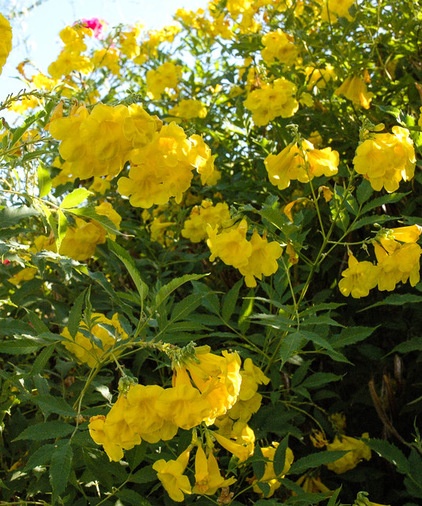
Yellow Bells
(Tecoma stans)
Native to southern Arizona and New Mexico, stretching toward western Texas on into Mexico and South America, growing alongside arroyos, hillsides and flat areas of land in elevations of 2,000 to 5,500 feet. This flowering shrub is also native to Florida.
Best shrub for a long bloom season. At first glance it is hard to believe that this tropical-looking, yellow-flowering shrub is native to the Southwest. The large, trumpet-shaped flowers of yellow bells against bright green foliage lend a slightly tropical feel to any desert landscape. The blooms of this medium- to large-size shrub begin to appear soon after the last frost in spring and continue blooming nonstop until just before the first frost in the fall. The golden-yellow blooms are a favorite of hummingbirds and bees alike, providing an important source of nectar.
Adding yellow bells with its long bloom period maximizes its impact, as opposed to plants that bloom for a few weeks and are done. For a tropical theme made up of drought-tolerant shrubs, plant yellow bells alongside bougainvillea and desert ruellia for a mixture of yellow, magenta and purple jewel-toned flowers.
With the approach of freezing temperatures, the growth of yellow bells will slow down, and frost damage to leaves and branches will occur sometimes down to the roots. But with the arrival of spring, regrowth is rapid.
See how to grow yellow bells
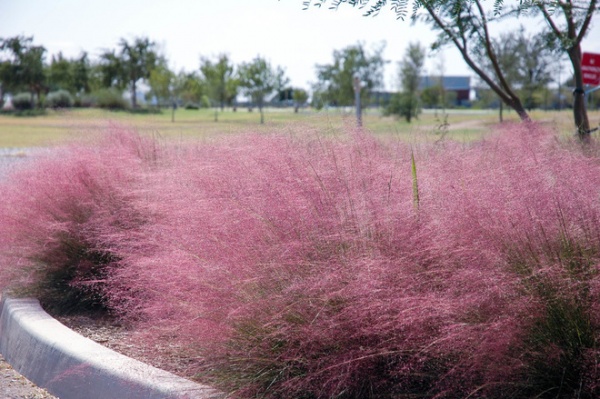
Pink Muhly
(Muhlenbergia capillaris)
Native to central and eastern regions of the United States as well as Texas, growing on the prairie and in open woodlands
Best ornamental grass for spectacular color. Ornamental grasses are popular choices for the landscape, where their graceful foliage provides both texture and contrast. While many ornamental grasses can be grown in the Southwest, pink muhly deserves a special place because of its spectacular fall display of color.
With the arrival of fall, a transformation takes place: The attractive green foliage becomes covered with plumes of pinkish-burgundy flowers, creating a rosy halo effect. The sight of the colorful plumes is enough to stop traffic.
As winter temperatures arrive, the pink plumes fade to an attractive wheat color that goes along with a winter-themed garden. Once spring arrives pink muhly produces new, attractive green foliage that lasts throughout the summer into fall.
This ornamental grass is easy to grow in either full sun or partial shade and can be grown in an informal cluster and paired with Murphy agave (Agave murpheyi), whose gray-blue leaves will provide great color contrast. You can always go with a more contemporary look and plant pink muhly in a straight row.
See how to grow pink muhly
More: Browse plants native to your region












